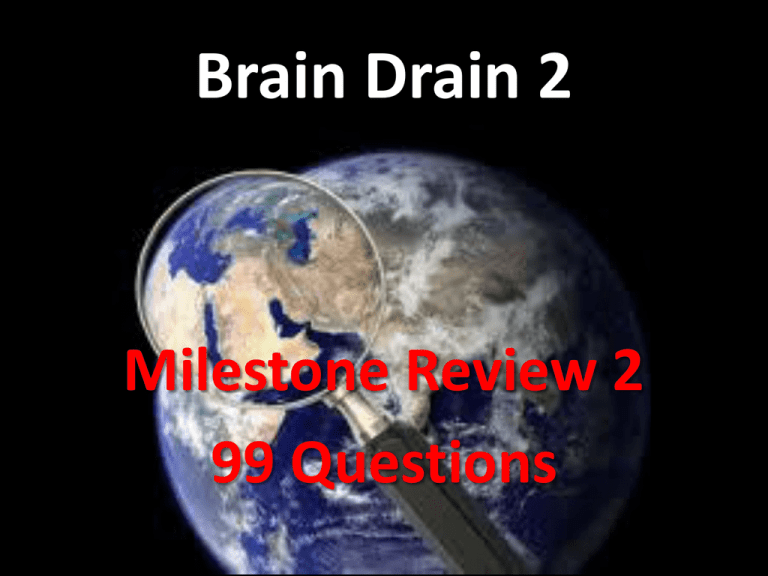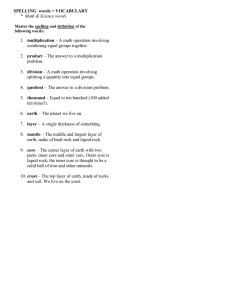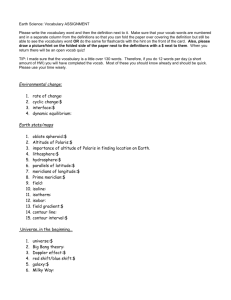weathering?
advertisement

Brain Drain 2 Milestone Review 2 99 Questions 1.) What is the theory that explains how the universe was created? Big Bang Theory 2.) What does maritime mean? Wet 3.) Rivers, steams, creeks are known as tributaries 4.) What is the percentage of Earth’s salt water? 97% 5.) Which crust is more dense, oceanic or continental? Oceanic 6.) What crust is the thickest? Continental 7.) In a collision between oceanic and continental which will subduct? Oceanic 8.) Law of superposition states that the farther you go down in the Earth the denser the rock. 9.) What is the main greenhouse gas on Earth? Carbon Dioxide 10.) What type of climate accelerates (to make faster) weathering? Warm and wet 11.) What are underwater mountain ranges known as? Mid-ocean Ridge 12.) Depositing sediment at the bottom of rivers is known as Deposition 13.) You have 73 mph wind. Is this a category 1 hurricane or tropical storm? Tropical storm 14.) You have 74 mph wind. Is this a category 1 hurricane or a tropical storm? Category 1 Hurricane 15.) What type of cloud is associated with hurricanes and thunderstorms? Cumulonimbus 16.) The process by which the ocean floor sinks beneath a deep ocean trench into the mantle is known as a subduction zone. 17.) What instrument measures wind speed? Anemometer 18.) What instrument measures temperature? Thermometer 19.) Igneous rock formed inside earth’s crust is known as Intrusive igneous rock. 20.) Igneous rock formed outside earth’s crust is known as extrusive igneous rock. 21.) The galaxy we live in is known as the Milky Way Galaxy. 22.) Our solar system is located on the outer arm or band of the galaxy. 23.) The galaxy we live in is known as a spiral galaxy. 24.) The tallest mountains on earth are located where? Under the ocean 25.) The longest mountain chains on earth are located where? Under the ocean. 26.) A person who studies whether is known as a 27.) What is an indirect method scientist use to study layers? Seismic waves 28.) What is a direct method scientist use to study layers? Rocks 29.) Conserve means to save 30.) An air mass coming from land is known as a land breeze 31.) An air mass coming from water is known as sea breeze 32.) A global wind coming from the poles is known as polar easterlies 33.) A global wind coming from the equator is known as trade winds 34.) What process is required to turn rock into sediment? Weathering 35.) This process carries sediment from one place to another. Erosion 36.) This process occurs when dissolved minerals crystallize and glue particles together. Cementation 37.) This layer of earth is soft and bends easy, it also means “weak” in Greek. Asthenosphere 38.) This layer is the top layer and means “stone” in Greek. Lithosphere 39.) What is the thickest layer of Earth? Mantle 40.) Continents slowly moving over millions of years is known as the Continental Drift Theory 41.) Scientist use sonar to map the surface of the ocean floor. 42.) The shaking and trembling of Earth due to shifting rock underneath is known as an earthquake 43.) A plateau is a large area of flat land elevated high above sea level. 44.) Area beneath earth surface where rock is under stress and breaks triggering an earthquake. Focus 45.) The Richter Scale is a rating an earthquakes magnitude is measured in. 46.) Liquefaction occurs when an earthquake’s violent shaking suddenly turns loose soft soil into mud. 47.) The Pacific Ring of Fire is where most of Earth’s volcanoes are located in the Pacific Ocean. 48.) Molten rock inside Earth’s crust is known as Magma 49.) Molten rock outside earth’s crust is known as Lava 50.) A hot spot is an area where material deep inside earth’s crust rises creating volcanoes. 51.) Which is safest? A dormant volcano or an extinct volcano? Extinct 52.) Principle that states processes that happened long ago operate the same today and have always operated is known as uniformitarianism 53.) Astronomer who came up with ellipses was Kepler. 54.) Astronomer who believed in a geocentric universe was Ptolemy. 55.) Astronomer who believed in a heliocentric universe was Copernicus 56.) The process when water seeps into cracks and freezes, expanding the rock is known as ice wedging. 57.) Animals burrowing is an example of physical weathering. 58.) Acid rain is an example of chemical weathering. 59.) Abrasion refers to the grinding away of a surface by water, wind, or gravity. 60.) Lichen is an acid produced by plants that breaks down rock. 61.) Iron combining with oxygen and water created rust, this is known as oxidation. 62.) Oxidation is known as chemical weathering. 63.) Soil that is easily penetrated by air or wind is known as permeable. 64.) What type of soil is least permeable? Clay 65.) What type of soil is most permeable? Sand 66.) The solid layer of rock at the bottom of soil profile is known as bedrock. 67.) A soil horizon is layer of soil that differs in color and texture from other layers above or below it. 68.) Decomposition is the breaking down of an organism. 69.) Contour plowing is a technique that allows farmers to plow on the natural curves of a slope. 70.) Terracing is a technique where farmers dig steeps with lips on hills to prevent erosion of topsoil. 71.) What 2 agents of erosion create mudslides? Gravity and water 72.) Where a river meets an ocean is known as a delta. 73.) Deep ocean currents are caused by temperature or salinity differences 74.) What creates waves? Wind 75.) What creates wind? The unequal heating and cooling of earths surface. 76.) During the day differences in land and sea temperature create a sea breeze 77.) During the night differences in land and sea temperature create a land breeze. 78.) What creates tides? Moons gravitational pull on Earth 79.) What creates surface currents? Wind 80.) Fossils are the preserved remains of traces of living organisms. 81.) Most fossils are found in sedimentary rock. 82.) What does centric mean? Center 83.) What stage of the water cycle comes after runoff? evaporation 84.) Where is most of Earth’s fresh water trapped? Glaciers 85.) Impermeable means water cannot penetrate. 86.) Underground layer of rock or sediment that holds water is an aquifer. 87.) An artesian well is a well that rises because of pressure within an aquifer. 88.) The zone farthest from land is known as the open ocean zone. 89.) From low tide to edge of continental shield is the neritic zone. 90.) Salinity is the measure of the amount of salt in a substance. 91.) The more salt dissolved in water the denser the water becomes. 92.) Wind and water curve due to the coriolis effect of earth spinning from west to east. 93.) The gulf stream is a warm current from the south atlantic to the north that warms up Europe. 94.) Pattern of temperature of a long period of time is known as climate. 95.) Atmospheric conditions at a specific time is known as weather. 96.) 30 degrees north and south of the equator are known as the horse latitudes. 97.) The point at which water vapor turns to liquid is dew point. 98.) Global winds blow steadily from specific directions over long distances all over Earth. 99.) The deadliest part of a hurricane is known as the eye wall.






